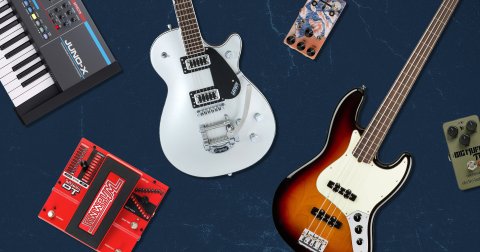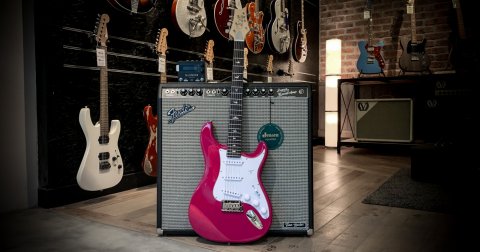On the fields of a dairy farm in the rural town of Bethel, New York, a mud-soaked crowd of 400,000 witnessed Jimi Hendrix’s rendition of Star Spangled Banner. It was 1969, and the crowd were treated to the squeals and wails of his white Stratocaster. What dominated his sound, was an effect called the wah-wah pedal. Before the wah, guitarists had just a handful of effects to play with, like tape delay and reverb, but this new sound was different. And it revolutionised music from there on.
The wah pedal wasn’t the only effect that dropped the jaws of its listeners. Here are five groundbreaking effects that took the guitar to all new heights.
Maestro Fuzz-Tone
- As used by: Keith Richards
- First seen: 1962
The first commercially available fuzz pedal, Gibson released the Maestro Fuzz-Tone in 1962 to an otherwise fuzzless world. “…creates a sensational new sound never played before on a guitar,” was on the adverts for the Fuzz-Tone and it introduced the world to not just a brand new sound, but the beginning of the age of the stompbox pedal.
The Fuzz-Tone introduced the sound of fuzz – that raucous, dirty, distorted, angry sound that voiced the frustrations of youth. Unfortunately, players weren’t too caught on Gibson’s idea of their new sound – rumour had it they only shipped three units in 1963. But that all changed in ‘65 when Keith Richards used the Fuzz-Tone on the Rolling Stones’ hit (I Can’t Get No) Satisfaction.
Vox Clyde McCoy Wah pedal
- As used by: Jimi Hendrix
- First seen: 1967
Everyone knows the wah pedal. From Hendrix’s Voodoo Child, to the funk theme song Shaft, the human-cry sounding wah pedal immortalised itself as one of the most iconic and instantly recognisable sounds. Initially designed for guitarists to emulate the mute of a trumpet (hence using the trumpeter Clyde McCoy’s name for marketing purposes), it is heard on countless records from the late 60s and 70s, used by artists like Eric Clapton, Terry Kath, George Harrison, Frank Zappa, and later on, Slash and Steve Vai. You just can’t be a rockstar without a wah pedal.
DigiTech Whammy
- As used by: Tom Morello
- First seen: 1991
If you’re going for the utter crazy, the DigiTech Whammy tops this list. When Rage Against The Machine released their debut album, listeners heard the insane effect used in an unorthodox fashion for the first time. Divebombs, siren wailing, pitch-bending noises were what the Whammy was capable of, and it was a sound that collectively got jaws dropping. Pitch Shifting effects weren’t new, but it was the DigiTech Whammy’s expression pedal that opened the floodgates for a plethora of inventive guitarists like Jack White, Dimebag Darrell, David Gilmour and Tom Morello to masterfully manipulate this distinctive effect.
Roland JC120
- As used by: Andy Summers
- First seen: 1975
Chorus was the sound of the 80s. Turn on any rock record of that period and you’re likely to find a chorus laced guitar riff. It took time for the effect to take off, with its first appearance in 1975. The Roland JC120 – JC for Jazz Chorus – wasn’t an effect pedal per se – it was an amplifier. But it was the amp’s built-in analog chorus and clean tone that got guitarists craving for more. Its circuitry went on to live in Boss’ first ever pedal – the Boss CE-1. Chorus may have been done to death by the turn of the century, but we all still love that lush, rich, soothing modulation that makes it one of the all-time great effects.
MXR Flanger
- As used by: Eddie Van Halen
- First seen: 1980
Whilst not the first Flanger sound to be heard by listeners, the MXR Flanger made waves when listeners first heard the whooshing, jet-plane-taking-off sounds on Van Halen’s Unchained. The first instances of “flanging” were when audio engineers played the same signal on two different tapes, then slowing one tape down so it became out of sync. Early examples of such flanging made in the studio were Jimi Hendrix’s psychedelic outro to Bold As Love. The Flanger was a popular effect during the modulation crazy era of the 80s, and it’s been one of the greatest tones in Rock ‘n’ Roll since.
Today, we are spoiled with endless array of effect pedals, both analog and digital, allowing us to get creative beyond imagination. Chase the sounds of your heroes or create your very own signature tone by giving the pedals at Swee Lee’s flagship store at The Star Vista a go, or take your time and explore our online store.



